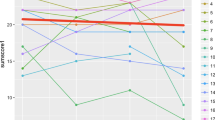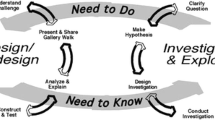Abstract
This study was conducted to investigate concept mapping as an instructional technique to help student designers tackle complex issues in instructional design. Specifically, this study focuses on three dimensions: perceived learning, collaborative learning, and usability. We examined how student designers perceived the use of Cacoo as a concept mapping tool in three different instructional design courses and how a concept mapping approach facilitated or constrained students’ design process. The study participants were 24 graduate students enrolled in three different courses over the span of a year. Through quantitative descriptive analysis and qualitative coding, our data revealed students’ overall positive perception toward Cacoo and demonstrated various means in which student designers successfully utilized the concept mapping approach to create external representations. We also provided implications for practitioners and recommendations for future researchers.


Similar content being viewed by others
References
Adesope, O. & Nesbit, J. (2009). Learning with collaborative concept maps: A meta-analysis. In T. Bastiaens, J. Dron & C. Xin (Eds.), Proceedings of E-Learn 2009--World Conference on E-Learning in Corporate, Government, Healthcare, and Higher Education (pp. 2082–2091). Vancouver, Canada: Association for the Advancement of Computing in Education (AACE). Retrieved from https://www.learntechlib.org/p/32771/.
Assaraf, O. B. Z., Dodick, J., & Tripto, J. (2013). High school students’ understanding of the human body system. Research in Science Education, 43(1), 33–56.
Ausubel, D. P., Novak, J. D., & Hanesian, H. (1978). Educational psychology: A cognitive view. NY: Holt, Rinehart, and Winston.
Baaki, J., & Luo, T. (2017). Stimulating students’ use of external representations for a distance education time machine design. TechTrends, 61, 355–365.
Baaki, J., Tracey, M. W., & Hutchinson, A. (2016). Give us something to react to and make it rich: designers reflecting-in-action with external representations. International Journal of technology and Design Education. https://doi.org/10.1007/s10798-016-9371-2.
Chiu, C. H. (2003). Exploring how primary school students function in computer supported collaborative learning. International Journal of Continuing Engineering Education and Life Long Learning, 13(3–4), 258–267.
Christensen, T. K., & Osguthorpe, R. T. (2004). How do instructional-design practitioners make instructional-strategy decisions? Performance Improvement Quarterly, 17(3), 45.
Cline, B. E., Brewster, C. C., & Fell, R. D. (2010). A rule-based system for automatically evaluating student concept maps. Expert Systems with Applications, 37(3), 2282–2291.
Conlon, T. (2006). Formative assessment of classroom concept maps: the reasonable fallible analyser. Journal of Interactive Learning Research, 17(1), 15–36.
Cross, N. (2011). Design thinking: Understanding how designers think and work. London: Berg Publishers.
Edmondson, K. M. (2000). Assessing science understanding through concept maps. In J. Mintzes, J. Wandersee, & J. Novak (Eds.), Assessing science understanding (pp. 15–40). San Diego: Academic Press.
Faste, H., & Lin, H. (2012). The untapped promise of digital mind maps. In Proceedings of the SIGCHI Conference on Human Factors in Computing Systems (pp. 1017–1026). ACM.
Gkotzos, D., & Potamias, G. (2012). Collaborative concept mapping via Multimodal ICT tools. In INTED2012 proceedings (pp. 4594–4600).
Gordon, J., & Zemke, R. (2000). The attack on ISD. Training, 37(4), 42–45.
Guindon, R. (1990). Designing the design process: exploiting opportunistic thoughts. Human Computer Interaction, 5, 305–344.
Harris, C., & Zha, S. (2013). Concept mapping: a critical thinking technique. Education, 134(2), 207–211.
Hay, D. B., & Kinchin, I. M. (2006). Using concept maps to reveal conceptual typologies. Education and Training, 48(2/3), 127–142.
Hay, D., Kinchin, I., & Lygo-Baker, S. (2008). Making learning visible: the role of concept mapping in higher education. Studies in Higher Education, 33(3), 295–311.
Hayes, J. (1980). The complete problem solver. Philadelphia: The Franklin Institute Press.
Huybrechts, L., Schoffelen, J., Schepers, S., & Braspenning, L. (2012). Design representations: Connecting, making, and reflecting in design research education. In D. Boutsen (Ed.), Good practices best practices: Highlighting the compound idea of education, creativity, research, and practice (pp. 35–42). Brussels: Sint-Lucas School of Architecture.
Hwang, G. J., Yang, L. H., & Wang, S. Y. (2013). A concept map-embedded educational computer game for improving students’ learning performance in natural science courses. Computers & Education, 69, 121–130. https://doi.org/10.1016/j.compedu.2013.07.008.
Hwang, G. J., Kuo, F. R., Chen, N. S., & Ho, H. J. (2014). Effects of an integrated concept mapping and web-based problem-solving approach on students’ learning achievements, perceptions and cognitive loads. Computers & Education, 71, 77–86. https://doi.org/10.1016/j.compedu.2013.09.013.
Jang, S. J. (2010). The impact on incorporating collaborative concept mapping with coteaching techniques in elementary science classes. School Science and Mathematics, 110(2), 86–97.
Jonassen, D. H. (1997). Instructional design models for well-structured and ill-structured problem-solving learning outcomes. Educational Technology Research and Development, 45(1), 65–95.
Kinchin, I. M., Hay, D. B., & Adams, A. (2000). How a qualitative approach to concept map analysis can be used to aid learning by illustrating patterns of conceptual development. Educational Research, 42(1), 43–57.
Lin, H., & Faste, H. (2011). Digital mind mapping: innovations for real-time collaborative thinking. In CHI'11 Extended Abstracts on Human Factors in Computing Systems (pp. 2137–2142). ACM.
Lincoln, Y. S., & Guba, E. G. (1985). Naturalistic inquiry. Beverly Hills: Sage Publications.
Liu, S. H., & Lee, G. G. (2013). Using a concept map knowledge management system to enhance the learning of biology. Computers & Education, 68, 105–116.
Martinez-Maldonado, R., Yacef, K., & Kay, J. (2015). TSCL: a conceptual model to inform understanding of collaborative learning processes at interactive tabletops. International Journal of Human-Computer Studies, 83, 62–82.
Nesbit, J. C., & Adesope, O. O. (2013). Concept maps for learning. In G. Schraw, M. T. McCrudden, & D. Robinson (Eds.), Learning through visual displays (pp. 303–328). Charlotte: Information Age Publishing.
Newell, A., & Simon, H. A. (1972). Human problem solving. Englewood Cliffs: Prentice-Hall.
Novak, J. D. (1998). Learning, creating and using knowledge: Concept maps as facilitative tools in schools and corporations. Mahwah: Lawrence Erlbaum.
Novak, J. D. (2010). Learning, creating, and using knowledge: Concept maps as facilitative tools in schools and corporations. Routledge.
Novak, J. D., & Gowin, D. B. (1984). Learning how to learn. Cambridge: Cambridge University Press.
O'Donnell, A., Reeve, J., & Smith, J. (2011). Educational psychology: Reflection for action. Wiley.
Perez, R. S., & Emery, C. D. (1995). Designer thinking: how novices and experts think about instructional design. Performance Improvement Quarterly, 8(3), 80–95.
Reiser, R. A. (2001). A history of instructional design and technology: part II: a history of instructional design. Educational Technology Research and Development, 49(2), 57–67.
Reiser, R. A., & Dempsey, J. V. (Eds.). (2017). Trends and issues in instructional design and technology. Boston: Pearson.
Rosen, Y., & Tager, M. (2014). Making student thinking visible through a concept map in computer-based assessment of critical thinking. Journal of Educational Computing Research, 50(2), 249–270.
Rumelhart, D. E. (1980). Schemata: The Building Blocks of Cognition (Theoretical Issues in Reading Comprehension ed.). Hillsdale: Erlbaum.
Schön, D. A. (1983). The reflective practitioner: How professionals think in action. Boston: Basics Books, Inc.
Schön, D. A. (1988). Designing: rules, types, and worlds. Design Studies, 9(3), 181–190.
Stenning, K., & Oberlander, J. (1995). A cognitive theory of graphical and linguistic reasoning: logic and implementation. Cognitive Science, 19, 97–140.
Stoyanov, S. (1997). Cognitive mapping as a learning method in hypermedia design. Journal of Interactive Learning Research, 8(3), 309–323.
Stoyanova, N., & Kommers, P. (2002). Concept mapping as a medium of shared cognition in computer-supported collaborative problem solving. Journal of Interactive Learning Research, 13(1), 111–133.
Taylor, S. E., & Crocker, J. (1981). Schematic bases of social information processing. In E. T. Higgins, C. A. Herman, & M. P. Zanna (Eds.), Social cognition: The Ontario symposium on personality and social psychology (pp. 89–134). Hillsdale: Erlbaum.
Tessmer, M., & Wedman, J. F. (1990). A layers-of-necessity instructional development model. Educational Technology Research and Development, 38(2), 77–85.
Tracey, M. W., Hutchinson, A., & Grzebyk, T. Q. (2014). Instructional designers as reflective practitioners: developing professional identity through reflection. Educational Technology Research and Development, 62(3), 315–334.
Van Boxtel, C., van der Linden, J. L., & Kanselaar, G. (2000). Collaborative learning tasks and the elaboration of conceptual knowledge. Learning and Instruction, 10(4), 311–330.
van Merriënboer, J. J., & Kirschner, P. A. (2007). Ten steps to complex learning: A systematic approach to four-component instructional design. Mahwah: Lawrence Erlbaum Associates, Publishers.
VanGundy, A. B. (1981). Techniques of structured problem solving. New York: Van Nostrand Reinhold.
Wang, H. Y., Huang, I., & Hwang, G. J. (2016). Effects of a question prompt-based concept mapping approach on students’ learning achievements, attitudes and 5C competences in project-based computer course activities. Journal of Educational Technology & Society, 19(3), 351.
Weinerth, K., Koenig, V., Brunner, M., & Martin, R. (2014). Concept maps: a useful and usable tool for computer-based knowledge assessment? A literature review with a focus on usability. Computers & Education, 78, 201–209.
Welch, M., Barlex, D., & Lim, H. S. (2000). Sketching: friend or foe to the novice designer? International Journal of Technology and Design Education, 102(2), 125–148.
Wu, P. H., Hwang, G. J., Milrad, M., Ke, H. R., & Huang, Y. M. (2012). An innovative concept map approach for improving students’ learning performance with an instant feedback mechanism. British Journal of Educational Technology, 43(2), 217–232.
Yang, C. C., Hwang, G. J., Hung, C. M., & Tseng, S. S. (2013). An evaluation of the learning effectiveness of concept map-based science book reading via mobile devices. Journal of Educational Technology & Society, 16(3), 167–178.
Author information
Authors and Affiliations
Corresponding author
Ethics declarations
Ethical Approval
All procedures performed in studies involving human participants were in accordance with the ethical standards of the institutional and/or national research committee and with the 1964 Helsinki declaration and its later amendments or comparable ethical standards.
Informed Consent
Informed consent was obtained from all individual participants included in the study.
Additional information
Publisher’s Note
Springer Nature remains neutral with regard to jurisdictional claims in published maps and institutional affiliations.
Rights and permissions
About this article
Cite this article
Luo, T., Baaki, J. Graduate Students Using Concept Mapping to Visualize Instructional Design Processes. TechTrends 63, 451–462 (2019). https://doi.org/10.1007/s11528-018-0368-4
Published:
Issue Date:
DOI: https://doi.org/10.1007/s11528-018-0368-4




